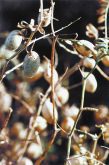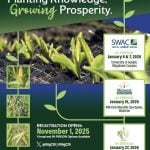Without herbicides, weeds often poke their flowers above the crop canopy. Organic growers who face outbreaks of mustard and thistle in their crops are searching for a solution with the help of PAMI researchers.
The Prairie Agricultural Machinery Institute is working with Dave Bauml, a farmer from Humboldt, Sask., who is attempting to adapt a swather to chop off the offending weed blooms. His machine needs some of the refinements that PAMI can provide.
“We needed something that reduced centre dumping of the swather design and used narrower wheels … . PAMI is going to improve our design,” said Bauml.
Read Also

Powerful solar storm lights up night time sky
Prairie skywatchers have been on high alert the last few nights as spectacular aurora displays have made the night time…
Jim Wassermann of PAMI said the design it is pursuing would damage the weed stalks and help prevent viable seed set.
The Saskatchewan Agriculture Development Fund has provided $98,672 for the project. The ADF is also funding two other projects that will benefit Saskatchewan’s growing organic agriculture industry.
An $82,090 commitment will pay for research into a herb and spice washing and drying machine. Herbs and spices are often root or low lying plants that require gentle washing and low temperature airflow drying so they are not damaged.
“We are designing a portable basket washer and drying system that will be mounted in a trailer and can move from farm to farm processing the herb and spice products,” said Wassermann.
Finally, $18,332 of ADF funding is being spent on a cultivator adaptation guide to be available this fall. Much of the prairie herb and spice industry is based in areas where row crop equipment is not available. Smaller farm equipment is often available at discount prices but requires adaptation for row crop use.
“There are a lot of smaller cultivators out there and we will be creating a guide that will help producers convert the machinery to row crop use,” said Wassermann.
A prototype of the herb and spice processing equipment will be operating for the fall harvest, but it and the weed topper are both two year projects, say PAMI researchers.














